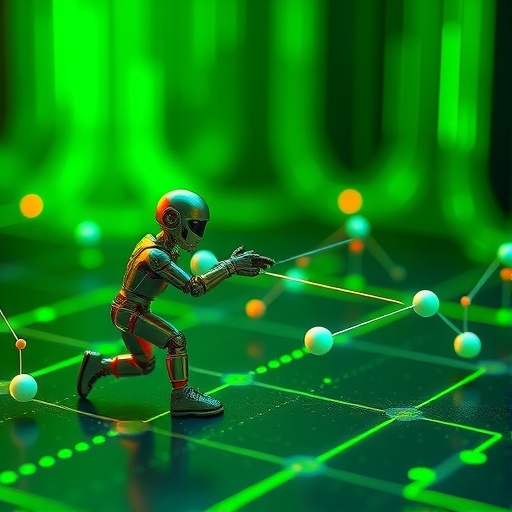In the quest to develop artificial intelligence that can adapt and learn as efficiently as biological entities, reinforcement learning (RL) has long stood as a cornerstone. RL algorithms guide agents to make decisions by learning from interactions with their environment, rewarding desirable actions, and discouraging poor ones. Although humans and animals have evolved remarkably sophisticated RL mechanisms over millions of years, artificial agents have historically relied on hand-crafted algorithms meticulously designed by researchers and engineers. This divide between naturally evolved and artificially engineered learning approaches highlights an enduring challenge: can machines themselves autonomously discover powerful RL algorithms capable of rivaling or surpassing human-designed methods?
Recent groundbreaking research, led by Oh, Farquhar, Kemaev, and colleagues, published in Nature in 2025, offers a resounding affirmative answer to this question. Their study marks a watershed moment in artificial intelligence by demonstrating that machines can indeed meta-learn, and thereby discover, an RL learning rule that outperforms state-of-the-art human-designed counterparts. This represents not just an incremental step but a paradigm shift in how reinforcement learning algorithms might be conceived in the future — no longer confined to handcrafted, static rules but dynamically shaped by machines learning from their own cumulative experiences.
The foundation of this advance rests on meta-learning from a vast collective pool of experiences gathered across a diverse population of agents operating within numerous complex environments. Instead of merely optimizing policies for specific tasks, the researchers’ method focuses on discovering the very rule that governs how an agent updates its policy and internal predictions in response to feedback. This top-level algorithmic discovery procedure enables the emergence of a learning rule that is highly generalizable and adaptable, transcending the environments it was initially trained on.
Central to their experimental framework is a large-scale setup wherein millions of agent-environment interactions were obtained across a rich and complex set of challenges. These environments extended well beyond simple or toy problems, incorporating intricate dynamics and requiring sophisticated strategies. By accumulating and distilling knowledge from this massive data corpus, the meta-learning system was able to synthesize an RL update rule that breaks free from conventional constraints and biases typically baked into hand-engineered algorithms.
When tested on the renowned Atari benchmark—a rigorous and widely accepted standard measuring reinforcement learning performance—the discovered rule did not merely match existing algorithms; it outperformed all known baselines, including several of today’s most advanced methods. This achievement highlights the potential for meta-discovered RL rules to unlock new levels of competence in agents tasked with complex decision-making problems.
But the real test of a learning algorithm lies in its ability to generalize to unseen domains and tasks. Impressively, the newly discovered RL rule demonstrated exceptional performance on a suite of challenging benchmarks that were not part of the original meta-learning training process. This cross-domain efficacy underscores the robustness and flexibility of the rule, signaling a significant stride towards adaptable, broadly applicable AI.
The implications of this research reach far beyond academic benchmarks. The discovery of powerful reinforcement learning algorithms via machine-driven meta-learning suggests a future where the development of AI capabilities could accelerate autonomously. By allowing artificial systems to derive their own learning procedures from collective experience, the pace of innovation in RL and AI could be greatly enhanced, potentially leading to breakthroughs in areas ranging from robotics and autonomous systems to complex strategic planning and decision support.
Moreover, this research serves as a blueprint for future AI studies seeking to push beyond human design limitations. By embracing the meta-learning paradigm, researchers can harness the computational power and vast data of modern AI infrastructures to explore algorithmic spaces that are otherwise inaccessible or too intricate for manual human design. This could herald an era where AI continues to self-improve not only by learning from new data but by innovating its learning mechanisms themselves.
At a theoretical level, the study enriches our understanding of learning dynamics, bridging the gap between natural and artificial intelligence. The meta-learned RL rule reflects an emergent intelligence shaped by cumulative adaptation—paralleling how evolution and experience shape biological learning rules but doing so at an unprecedented computational scale and speed. This may help unravel deeper insights into the principles of efficient learning and adaptation underpinning both natural and synthetic agents.
Pragmatically, the research opens avenues for creating agents capable of lifelong learning, continuously refining their decision-making strategies in real-world settings without human intervention. This capability is indispensable for developing autonomous systems that can operate reliably in dynamic, complex, and unpredictable environments, such as self-driving vehicles, personalized healthcare assistants, and autonomous exploration robots.
The technical underpinning of this meta-learning approach leverages advanced machine learning architectures and optimization techniques designed to identify patterns and efficacy across myriad agent trajectories and feedback loops. These architectures iteratively refine the update rule using gradient-based meta-optimization, effectively “learning to learn” from a population-level data aggregation perspective. The methodological innovation lies not just in architecture but in framing RL rule discovery as a scalable learning procedure itself.
While challenges remain—such as interpretability of the discovered rules and ensuring stability across even broader environmental diversity—the demonstrated success sets a new standard and provides a robust experimental template for future explorations. As computational resources continue to grow and AI research embraces meta-learning techniques, we can expect an accelerating trend of algorithmic self-discovery that reshapes the landscape of artificial intelligence.
In summary, the research by Oh, Farquhar, Kemaev et al. represents a landmark achievement in reinforcement learning and AI. By demonstrating the autonomous discovery of a new RL update rule that surpasses human-designed counterparts across multiple benchmarks, the study paves the way towards a future in which powerful AI learning algorithms emerge from the experience of artificial agents themselves. This exciting advance offers a glimpse into a next generation of adaptive, generalizable, and automated AI systems poised to revolutionize the field.
Subject of Research: Autonomous discovery of reinforcement learning algorithms via meta-learning.
Article Title: Discovering state-of-the-art reinforcement learning algorithms.
Article References:
Oh, J., Farquhar, G., Kemaev, I. et al. Discovering state-of-the-art reinforcement learning algorithms.
Nature (2025). https://doi.org/10.1038/s41586-025-09761-x
Image Credits: AI Generated
Tags: adaptive AI learning mechanismsautonomous discovery of learning rulesbreakthroughs in machine learningcutting-edge reinforcement learning algorithmsdynamic RL algorithm developmentevolution of reinforcement learningfuture of artificial intelligence algorithmsintelligent agents decision-makingmeta-learning in artificial intelligenceNature publication on AI researchovercoming human-designed algorithmsparadigm shift in AI learning



